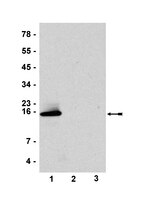Chromatin-to-nucleoprotamine transition is controlled by the histone H2B variant TH2B.
Montellier, E; Boussouar, F; Rousseaux, S; Zhang, K; Buchou, T; Fenaille, F; Shiota, H; Debernardi, A; Héry, P; Curtet, S; Jamshidikia, M; Barral, S; Holota, H; Bergon, A; Lopez, F; Guardiola, P; Pernet, K; Imbert, J; Petosa, C; Tan, M; Zhao, Y; Gérard, M; Khochbin, S
Genes & development
27
1680-92
2013
Show Abstract
The conversion of male germ cell chromatin to a nucleoprotamine structure is fundamental to the life cycle, yet the underlying molecular details remain obscure. Here we show that an essential step is the genome-wide incorporation of TH2B, a histone H2B variant of hitherto unknown function. Using mouse models in which TH2B is depleted or C-terminally modified, we show that TH2B directs the final transformation of dissociating nucleosomes into protamine-packed structures. Depletion of TH2B induces compensatory mechanisms that permit histone removal by up-regulating H2B and programming nucleosome instability through targeted histone modifications, including lysine crotonylation and arginine methylation. Furthermore, after fertilization, TH2B reassembles onto the male genome during protamine-to-histone exchange. Thus, TH2B is a unique histone variant that plays a key role in the histone-to-protamine packing of the male genome and guides genome-wide chromatin transitions that both precede and follow transmission of the male genome to the egg. | Western Blotting | | 23884607
 |
Putative molecular mechanism underlying sperm chromatin remodelling is regulated by reproductive hormones.
Gill-Sharma, MK; Choudhuri, J; Ansari, MA; D'Souza, S
Clinical epigenetics
4
23
2011
Show Abstract
The putative regulatory role of the male reproductive hormones in the molecular mechanism underlying chromatin condensation remains poorly understood. In the past decade, we developed two adult male rat models wherein functional deficits of testosterone or FSH, produced after treatments with 20 mg/Kg/d of cyproterone acetate (CPA) per os, for a period of 15 days or 3 mg/Kg/d of fluphenazine decanoate (FD) subcutaneously, for a period of 60 days, respectively, affected the rate of sperm chromatin decondensation in vitro. These rat models have been used in the current study in order to delineate the putative roles of testosterone and FSH in the molecular mechanism underlying remodelling of sperm chromatin.We report that deficits of both testosterone and FSH affected the turnover of polyubiquitylated histones and led to their accumulation in the testis. Functional deficits of testosterone reduced expression of MIWI, the 5-methyl cap binding RNA-binding protein (PIWIlike murine homologue of the Drosophila protein PIWI/P-element induced wimpy testis) containing a PAZ/Piwi-Argonaut-Zwille domain and levels of histone deacetylase1 (HDAC1), ubiquitin ligating enzyme (URE-B1/E3), 20S proteasome α1 concomitant with reduced expression of ubiquitin activating enzyme (ube1), conjugating enzyme (ube2d2), chromodomain Y like protein (cdyl), bromodomain testis specific protein (brdt), hdac6 (histone deacetylase6), androgen-dependent homeobox placentae embryonic protein (pem/RhoX5), histones h2b and th3 (testis-specific h3). Functional deficits of FSH reduced the expression of cdyl and brdt genes in the testis, affected turnover of ubiquitylated histones, stalled the physiological DNA repair mechanism and culminated in spermiation of DNA damaged sperm.We aver that deficits of both testosterone and FSH differentially affected the process of sperm chromatin remodelling through subtle changes in the 'chromatin condensation transcriptome and proteome', thereby stalling the replacement of 'dynamic' histones with 'inert' protamines, and altering the epigenetic state of condensed sperm chromatin. The inappropriately condensed chromatin affected the sperm chromatin cytoarchitecture, evident from subtle ultrastructural changes in the nuclei of immature caput epididymal sperm of CPA- or FD-treated rats, incubated in vitro with dithiothreitol. | Western Blotting | | 23241214
 |
Distinctive chromatin in human sperm packages genes for embryo development.
Hammoud, SS; Nix, DA; Zhang, H; Purwar, J; Carrell, DT; Cairns, BR
Nature
460
473-8
2009
Show Abstract
Because nucleosomes are widely replaced by protamine in mature human sperm, the epigenetic contributions of sperm chromatin to embryo development have been considered highly limited. Here we show that the retained nucleosomes are significantly enriched at loci of developmental importance, including imprinted gene clusters, microRNA clusters, HOX gene clusters, and the promoters of stand-alone developmental transcription and signalling factors. Notably, histone modifications localize to particular developmental loci. Dimethylated lysine 4 on histone H3 (H3K4me2) is enriched at certain developmental promoters, whereas large blocks of H3K4me3 localize to a subset of developmental promoters, regions in HOX clusters, certain noncoding RNAs, and generally to paternally expressed imprinted loci, but not paternally repressed loci. Notably, trimethylated H3K27 (H3K27me3) is significantly enriched at developmental promoters that are repressed in early embryos, including many bivalent (H3K4me3/H3K27me3) promoters in embryonic stem cells. Furthermore, developmental promoters are generally DNA hypomethylated in sperm, but acquire methylation during differentiation. Taken together, epigenetic marking in sperm is extensive, and correlated with developmental regulators. | | Human | 19525931
 |











